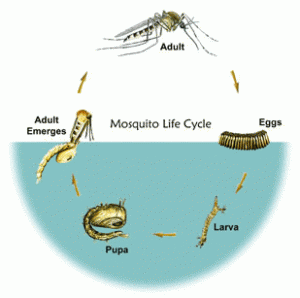 The mosquito goes through four distinct stages of its life cycle; Egg, Larva, Pupa, and Adult. Eggs are laid one at a time or attached together to form “rafts.” They float on the surface of the water. In the case of Culex and Culiseta species, the eggs are stuck together in rafts of up to 200.
The mosquito goes through four distinct stages of its life cycle; Egg, Larva, Pupa, and Adult. Eggs are laid one at a time or attached together to form “rafts.” They float on the surface of the water. In the case of Culex and Culiseta species, the eggs are stuck together in rafts of up to 200.
The larva lives in the water and comes to the surface to breathe. Most larvae have siphon tubes for breathing and hang upside down from the water surface.
The pupal stage is a resting, non-feeding stage of development, but pupae are mobile, responding to light changes and moving with a flip of their tails towards the bottom or protective areas.
When development is complete, the pupal skin splits and the adult mosquito emerges.
The newly emerged adult rests on the surface of the water for a short time to allow itself to dry and all its body parts to harden. The wings have to spread out and dry properly before it can fly. Blood feeding and mating does not occur for a couple of days after the adults emerge.
Mosquitoes lay their eggs in four types of water environments:
- Containers. Mosquito eggs are laid on the sides of the container. When the container is filled with rainwater or other means of watering, the eggs hatch. Most of these mosquitoes stay within 100 feet of their breeding site. Typical sites are old tires, bird baths, clogged gutters, flower pots, and buckets.
- Flood waters. Mosquito eggs are laid on moist soil that is flooded by rising streams and rivers. The eggs hatch when the area is flooded. Adult mosquitoes of this type can fly great distances, as far as twenty miles.
- Permanent waters. Mosquito eggs are laid in permanent waters such as ponds and lakes where the eggs are laid directly on the water.
- Temporary water pools. Mosquito eggs are laid in pools of a temporary nature. Typical sites are roadside ditches, canals, ground pools, tire ruts, clogged streams, irrigated lands, etc.
Mosquitoes mostly feed on plant nectar. Only Female mosquitoes seek hosts for blood, and only then as a protein source before reproduction. They are attracted to hosts by CO2, octenol and heat and with their infrared vision they can detect blood concentrations on the skin’s surface.
